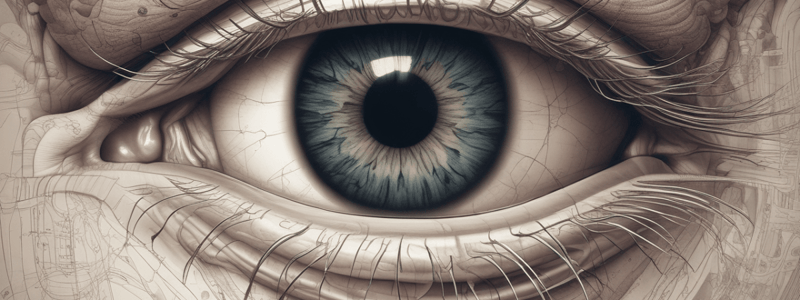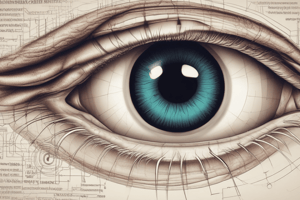Podcast
Questions and Answers
Approximately what percentage of glaucoma patients have pressure within normal limits?
Approximately what percentage of glaucoma patients have pressure within normal limits?
- 40%
- 30% (correct)
- 20%
- 10%
What is the name of the artery that supplies the optic disc?
What is the name of the artery that supplies the optic disc?
- Ophthalmic Artery
- Short Posterior Ciliary Arteries
- Circle of Zinn
- Central Retinal Artery (correct)
What is the term for the imbalance in anterior fluid dynamics that can give rise to increased IOP?
What is the term for the imbalance in anterior fluid dynamics that can give rise to increased IOP?
- Pseudoexfoliation
- An imbalance in anterior fluid dynamics (correct)
- Anterior chamber inflammation
- Angle closure
What is the name of the structure that is usually pale and allows it to be distinguished from the neuro-retinal rim tissue?
What is the name of the structure that is usually pale and allows it to be distinguished from the neuro-retinal rim tissue?
What is the term for the localised loss of nerve fibre layer?
What is the term for the localised loss of nerve fibre layer?
What is the shape of the normal optic disc?
What is the shape of the normal optic disc?
What is the primary method to define the edge of the cup?
What is the primary method to define the edge of the cup?
In which type of glaucoma is pupil block a contributing factor?
In which type of glaucoma is pupil block a contributing factor?
What is the recommended course of action for all angle closure glaucoma cases?
What is the recommended course of action for all angle closure glaucoma cases?
What is the primary purpose of gonioscopy assessment in glaucoma?
What is the primary purpose of gonioscopy assessment in glaucoma?
What is the characteristic of a nasal step defect in glaucoma?
What is the characteristic of a nasal step defect in glaucoma?
What is the purpose of NICE guidelines in glaucoma management?
What is the purpose of NICE guidelines in glaucoma management?
What is the characteristic of an artefact in auto-perimetry?
What is the characteristic of an artefact in auto-perimetry?
What is the primary purpose of evaluating the visual field in glaucoma?
What is the primary purpose of evaluating the visual field in glaucoma?
What is the recommended course of action for a patient with a possible cilio-retinal vessel?
What is the recommended course of action for a patient with a possible cilio-retinal vessel?
What is the characteristic of a diffuse field loss in glaucoma?
What is the characteristic of a diffuse field loss in glaucoma?
What is the primary function of the Short Posterior Ciliary Arteries in the optic disc?
What is the primary function of the Short Posterior Ciliary Arteries in the optic disc?
What is the implication of an imbalance in anterior fluid dynamics on the optic disc?
What is the implication of an imbalance in anterior fluid dynamics on the optic disc?
What is the characteristic of the scleral ring in the optic disc?
What is the characteristic of the scleral ring in the optic disc?
What is the significance of the neuro-retinal rim tissue in the optic disc?
What is the significance of the neuro-retinal rim tissue in the optic disc?
What is the purpose of assessing the optic disc in glaucoma?
What is the purpose of assessing the optic disc in glaucoma?
What is the characteristic of the cup in the optic disc?
What is the characteristic of the cup in the optic disc?
In cases where the edge may be an overhang, what can be used to help identify the cup edge?
In cases where the edge may be an overhang, what can be used to help identify the cup edge?
What is the term for the mechanism that can cause angle closure in primary glaucoma?
What is the term for the mechanism that can cause angle closure in primary glaucoma?
What is the recommended course of action for patients with angle closure glaucoma?
What is the recommended course of action for patients with angle closure glaucoma?
What is the purpose of evaluating the visual field in glaucoma?
What is the purpose of evaluating the visual field in glaucoma?
What can cause a false positive result in auto-perimetry?
What can cause a false positive result in auto-perimetry?
What is the recommended course of action for patients with grade 1 angles (Van Herick)?
What is the recommended course of action for patients with grade 1 angles (Van Herick)?
What is the purpose of NICE guidelines in glaucoma management?
What is the purpose of NICE guidelines in glaucoma management?
What type of glaucoma is associated with pupil block and bowing of the iris forward?
What type of glaucoma is associated with pupil block and bowing of the iris forward?
What is the characteristic of an arcuate defect in glaucoma?
What is the characteristic of an arcuate defect in glaucoma?
What is the purpose of evaluating the retinal nerve fibre layer (RNFL) in glaucoma?
What is the purpose of evaluating the retinal nerve fibre layer (RNFL) in glaucoma?
Flashcards
Glaucoma & Normal Pressure
Glaucoma & Normal Pressure
Many nerve fibers can be lost before visual field defects are noticeable.
Optic Disc Assessment Tools
Optic Disc Assessment Tools
78/90D lens and slit-lamp, and direct ophthalmoscope.
Normal Optic Disc Shape
Normal Optic Disc Shape
Slightly vertically oval.
Optic Nerve Head Blood Supply
Optic Nerve Head Blood Supply
Signup and view all the flashcards
Glaucoma & Fluid Dynamics
Glaucoma & Fluid Dynamics
Signup and view all the flashcards
Causes of Increased IOP
Causes of Increased IOP
Signup and view all the flashcards
Sign of Glaucoma: Cupping
Sign of Glaucoma: Cupping
Signup and view all the flashcards
Sign of Glaucoma: NRR Loss
Sign of Glaucoma: NRR Loss
Signup and view all the flashcards
Sign of Glaucoma: Pallor
Sign of Glaucoma: Pallor
Signup and view all the flashcards
Sign of Glaucoma: Vessel Deviations
Sign of Glaucoma: Vessel Deviations
Signup and view all the flashcards
Sign of Glaucoma: PPA/Hemorrhages
Sign of Glaucoma: PPA/Hemorrhages
Signup and view all the flashcards
Sign of Glaucoma: NFL Defect
Sign of Glaucoma: NFL Defect
Signup and view all the flashcards
Sign of Glaucoma: Lamina Cribrosa
Sign of Glaucoma: Lamina Cribrosa
Signup and view all the flashcards
Defining the Cup Edge
Defining the Cup Edge
Signup and view all the flashcards
Disc Size & Cupping
Disc Size & Cupping
Signup and view all the flashcards
Small Discs & Cupping Risk
Small Discs & Cupping Risk
Signup and view all the flashcards
PDR/Carotid Occlusion
PDR/Carotid Occlusion
Signup and view all the flashcards
Primary Angle Closure
Primary Angle Closure
Signup and view all the flashcards
Secondary Angle Closure
Secondary Angle Closure
Signup and view all the flashcards
Angle Closure Referral
Angle Closure Referral
Signup and view all the flashcards
Glaucomatous Defects
Glaucomatous Defects
Signup and view all the flashcards
Visual Fields & Diagnosis
Visual Fields & Diagnosis
Signup and view all the flashcards
NICE Guidelines & Glaucoma
NICE Guidelines & Glaucoma
Signup and view all the flashcards
Unequivocal VF Signs
Unequivocal VF Signs
Signup and view all the flashcards
Suspicious VF Signs
Suspicious VF Signs
Signup and view all the flashcards
Glaucomatous VF Defect
Glaucomatous VF Defect
Signup and view all the flashcards
Arcuate Scotoma
Arcuate Scotoma
Signup and view all the flashcards
Altitudinal Scotoma
Altitudinal Scotoma
Signup and view all the flashcards
Nasal Step
Nasal Step
Signup and view all the flashcards
Focal Defect
Focal Defect
Signup and view all the flashcards
Study Notes
Optic Disc Assessment and Anatomy
- 30% of glaucoma patients have pressure within normal limits, and large numbers of fibers can be lost before a visual field defect can be demonstrated.
- Tools used to assess the optic disc: 78 or 90D lens and slit-lamp, and direct ophthalmoscope.
- The normal optic disc head is slightly vertically oval, and a normal cup often appears slightly horizontally oval.
Blood Supply to the Optic Nerve Head
- Short Posterior Ciliary Arteries
- Circle of Zinn
- Ophthalmic Artery
- Central Retinal Artery
- Lamina Cribrosa
Aqueous Fluid Dynamics and Glaucoma
- An imbalance in anterior fluid dynamics can give rise to increased IOP.
- Examples: angle closure/narrowing, pseudoexfoliation, PDS, anterior chamber inflammation, trauma.
Signs of Glaucoma
- Enlargement of the cup
- Localized loss of neuroretinal rim (NRR)
- Pallor
- Vessel deviations
- PPA (peripapillary atrophy) disc hemorrhages
- Nerve fiber layer defect
- Lamina cribrosa
Defining the Edge of the Cup
- The inner edge of the neuroretinal rim (=cup edge) may be sloped (especially on the temporal side of the disc) or vertical.
- Use small to medium-sized blood vessels to define the cup edge by tracing their path across the scleral ring and then over the rim tissue.
Additional Points
- Larger discs (>2mm) tend to display larger cup-disc ratios.
- Cupping in small discs increases the risk of BRVO (branch retinal vein occlusion).
- Proliferative diabetic retinopathy and carotid artery obstruction are related to CRAO (central retinal artery occlusion).
Angle Closure Glaucoma
- Primary: 0.5% prevalence in age >40, associated with pupil block, causing bowing of the iris forward leading to angle closure.
- Secondary: variety of mechanisms other than pupil block (not relieved by iridotomy/iridectomy).
- Refer all angle closure urgently, and consider referral of all angles of grade 1 (Van Herick) for gonioscopy assessment.
Visual Fields Revision
- Glaucomatous defect: look for corresponding optic nerve head changes.
- Exclude alternative diagnoses.
- NICE guidelines: look for unequivocal, suspicious, and early signs of glaucoma.
NICE Guidelines on Fields
- Threshold or suprathreshold: glaucomatous changes of the visual field that reflect nerve fiber bundle loss.
- Unequivocal signs: arcuate scotomas, nasal steps, altitudinal scotomata, focal defects, and absolute defects.
- Suspicious signs: generalized defect, relative defect, and enlarged blind spot.
- Early stages: mean defect >-6dB, 5% probability level defect for.
Studying That Suits You
Use AI to generate personalized quizzes and flashcards to suit your learning preferences.




